To view previous releases, select one from the dropdown box:
Currently displaying information released on: September, 2022
ANALYSIS OF NOVA SCOTIA'S CONSUMER PRICE INDEX FOR AUGUST 2022
TRENDS – August 2022
Nova Scotia’s All-Items Consumer Price Index (CPI) increased 7.8% year-over-year in August 2022, down from the 8.7% year-over-year increase in July and the 9.3% increase in June. Nationally, consumer prices also decelerated from 7.6% last month to being 7.0% higher than August 2021.
Inflation was highest in Prince Edward Island (+8.3%) while Alberta (+6.0%) had the lowest. Compared to the previous month, all provinces had slower year-over-year inflation.
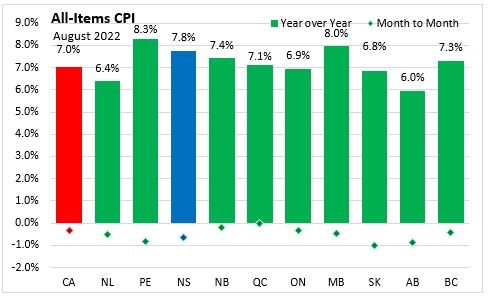
Nova Scotia’s consumer price inflation (year-over-year) excluding food and energy increased 5.0% in August 2022, unchanged from last month. Consumer prices excluding food and energy were up in all provinces led by British Columbia (+6.3%). Newfoundland and Labrador had the smallest increase at 3.5%.
For Canada, prices for travel and durable goods increased at slower rates than last month.
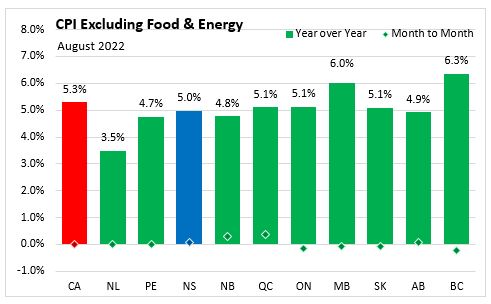
The CPI for food in Nova Scotia increased 9.4% year-over-year in August 2022. Nationally, food prices were also up 9.8% from a year earlier. All provinces recorded year-over-year increase in food prices led by Prince Edward Island and Manitoba (both +10.8%). The lowest food inflation was reported in Nova Scotia, Alberta, and British Columbia (all +9.4%).
Canadians paid 10.8% more for food purchased from stores when compared to August 2021 - the fastest pace of increase since 1981. Multiple factors including weather, higher input costs, Russia's invasion of Ukraine and supply chain disruptions are contributing to higher food costs. Food inflation remains broad-based with increases at national level for meat (+6.5%), dairy products (+7.0%), bakery products (+15.4%), fresh fruit (+13.2%), non-alcoholic beverages (+14.1%), condiments, spices, and vinegars (+17.2%), sugar and confectionery (+11.3%), and fish, seafood, and other marine products (+8.7%).
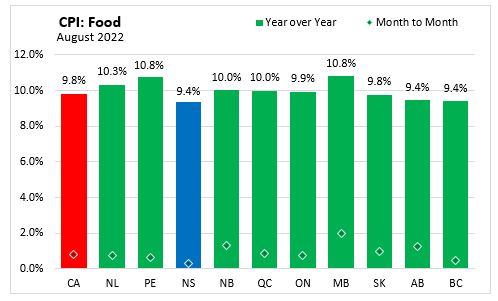
Year-over-year, shelter costs in Nova Scotia increased 8.2% in August 2022, slowing form 9.2% increase in July 2022.
In August, shelter prices increased 6.6% year-over-year across Canada, slower than the 7.0% year-over-year increase recorded in July. There was slower growth as housing markets cooled with slower owned accommodation expenses, related to real estate commissions, and homeowners' replacement costs, which is related to new home prices. The mortgage interest cost index increased at a faster pace with the higher interest rate environment.
Compared to August 2021, shelter prices were up in all provinces with the largest increase in Prince Edward Island (+9.0%) and the smallest increase in Alberta (+4.7%).
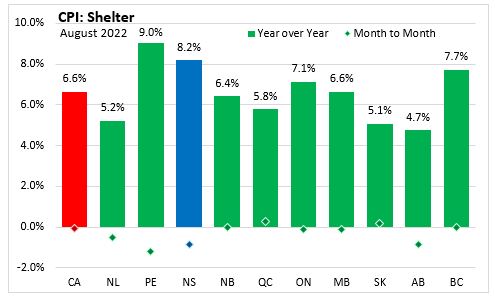
Nova Scotia's consumer price inflation (year-over-year growth in CPI) for energy was 25.1% in August, above the national average of 19.0%. Prince Edward Island (+30.4%) posted the largest year-over-year increases while Alberta (+8.9%) had the smallest change in the energy index.
Energy prices were lower in all provinces compared to July 2022. For Canada, consumers paid 9.6% less in gasoline in August compared to July with largest declines in Saskatchewan and Alberta

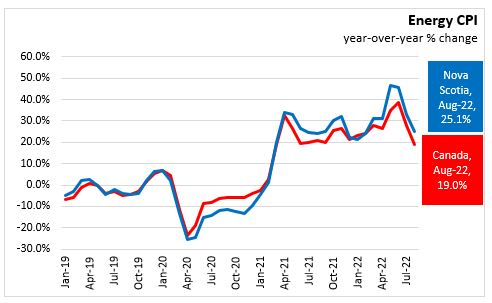
Nova Scotia's consumer price inflation (year-over-year growth in CPI) excluding energy was 5.9% in August compared to a national rate of 6.1%. British Columbia and Manitoba (both +6.8%) posted the largest year-over-year gain while Newfoundland and Labrador (+4.7%) had the smallest change in the CPI excluding energy.

Major Components for August 2022
The following table shows the price increases specific to Nova Scotia for the major components of the CPI this month.
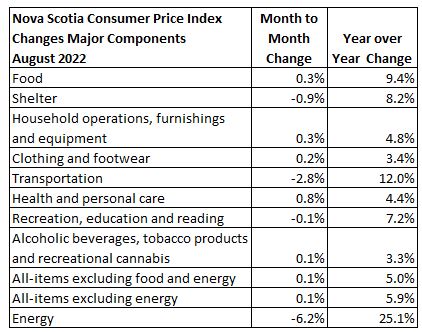
The main contributors to the monthly change (August 2022 vs July 2022) in Nova Scotia CPI were:
- Traveller accommodation (+11.5%)
- Clothing accessories, watches and jewellery (+7.8%)
- Mortgage interest costs (positive, not reported)
- Gasoline (-8.9%)
- Fuel oil and other fuels (-7.4%)
- Rent (-1.6%)
The main contributors to the yearly change (August 2022 vs August 2021) in Nova Scotia CPI were:
- Gasoline (+26.7%)
- Fuel oil and other fuels (+50.0%)
- Traveller accommodation (+68.1%)
- Video and audio subscription services (-11.3%)
- Child care and housekeeping services (-13.0%)
- Telephone services (-4.0%)
Long Run Trends
In August 2022, the all-items CPI year-over-year inflation rate for Nova Scotia was 7.8%, above the national inflation rate of 7.0%.
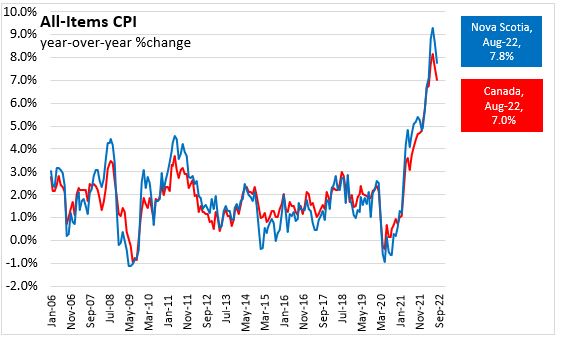
Nova Scotia’s CPI excluding food and energy increased 5.0%. Canada CPI excluding food and energy rose 5.3%. The NS CPI excluding food and energy was previously higher in March 2003 (+5.1%).
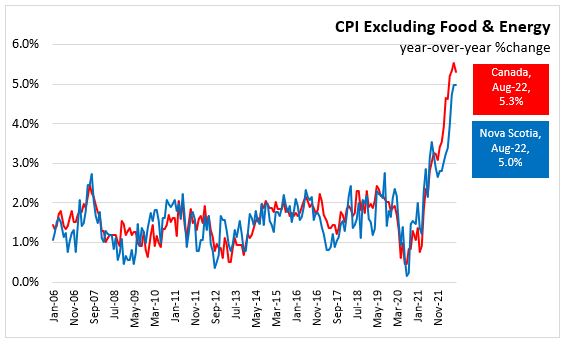
Bank of Canada's preferred measures of core inflation
Compared to August 2021, CPI-Common increased 5.7%, CPI-Median increased 4.8% and CPI-Trim was up 5.2% in Canada. All-items CPI excluding eight of the most volatile components as defined by the Bank of Canada and excluding the effect of changes in indirect taxes (formerly referred to as CPIX), rose 5.8% year-over-year. The change in the core inflation measures was down 0.3 percentage points for CPI-common, down 0.2 percentage points for CPI-trim and down 0.2 percentage point for CPI-median from the previous 12-month period.
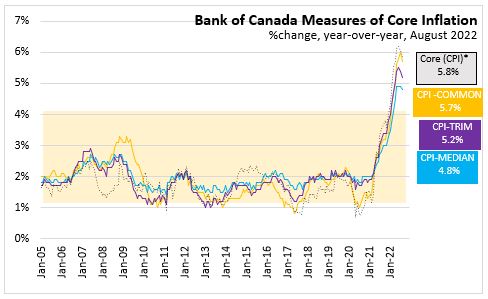
Appendix Tables and Charts

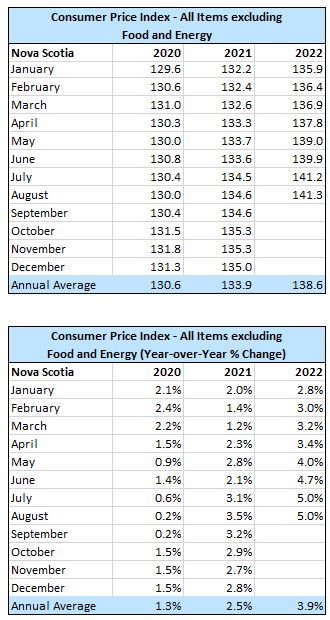
Basket Update - May 2022
As part of schedule update, Statistics Canada has updated the basket weights based on 2021 expenditures. A used vehicle price was introduced into the CPI Compared to the previous basket reference year of 2020 for Nova Scotia, increase weight for transportation (+2.04 percentage points) and clothing and footwear (+0.52 percentage points) were offset by lower weights for food (-0.5 percentage points), shelter (-0.53 percentage points), health and personal care (-0.65 percentage points) and recreation, education and reading (-0.5 percentage points). Statistics Canada noted that at national level the headline CPI growth rate would be the same using the previous weights. For full details on the weight update, see An Analysis of the 2022 Consumer Price Index Basket Update, Based on 2021 Expenditures.
Source: Statistics Canada. Table 18-10-0004-01 Consumer Price Index, monthly, not seasonally adjusted; Table 18-10-0256-01 Consumer Price Index (CPI) statistics, measures of core inflation and other related statistics - Bank of Canada definitions CONSUMER PRICE INDEX, AUGUST 2022
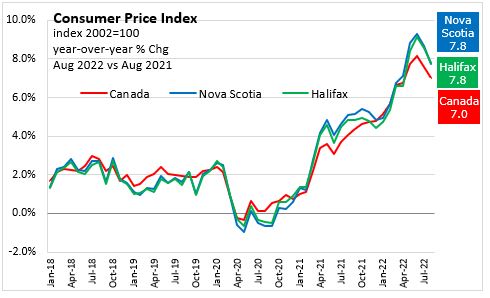
YEAR-OVER-YEAR (August 2022 vs August 2021)
All items (index 2002=100)
Consumer prices in Nova Scotia increased 7.8%. The national average was 7.0%. In Halifax consumer prices increased 7.8%.
Excluding food and energy (index 2002=100)
Nova Scotia consumer prices increased 5.0%. This was lower than the national average increase of 5.3%.
MONTH-OVER-MONTH (August 2022 vs July 2022)
All items (index 2002=100)
Consumer prices in Nova Scotia decreased 0.6%. This was a larger decline than the national average decrease of 0.3%. In Halifax consumer prices decreased 0.5%.
Excluding food and energy (index 2002=100)
Nova Scotia consumer prices increased 0.1%. This was a larger increase than the national average which did not change compared to last month
Source: Statistics Canada. Table 18-10-0004-01 Consumer Price Index, monthly, not seasonally adjusted EU AND EURO AREA CONSUMER PRICE INDEX, AUGUST 2022
Year-over-year (August 2022 vs. August 2021)
The inflation rate moved up to 10.1% in the European Union and was up to 9.1% in the Euro Area in August 2022.
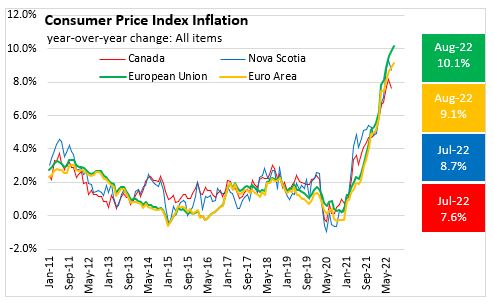
The fastest inflation was reported in Estonia (+25.2%), Latvia (+21.4%), and Lithuania (+21.1%) and the lowest inflation rates were in France (6.6%) and Malta (7.0%).
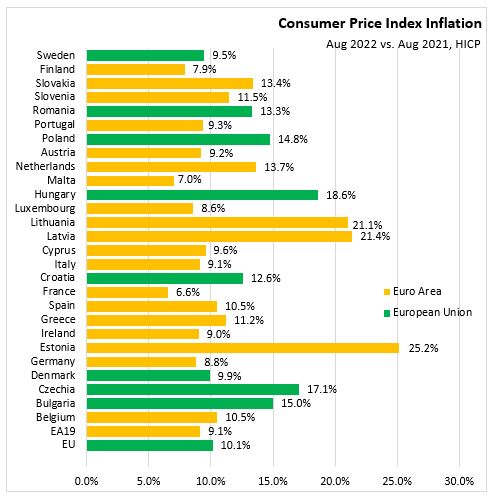
Food price inflation increased to 14.3% in the European Union and to 12.7% in the Euro Area.
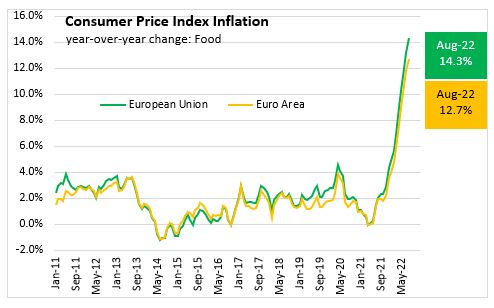
Energy inflation moderately slowed to 37.5% in the European Union and 38.6% in the Euro Area.
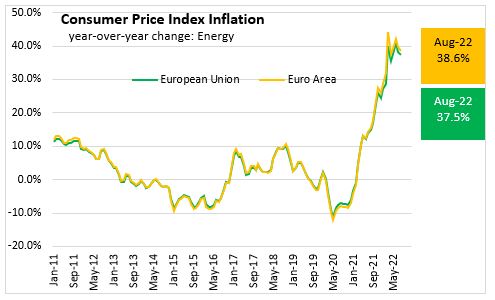
Excluding the impacts of energy, food, alcohol and tobacco prices inflation increased to 5.2% in the European Union and 4.3% in the Euro Area in August.
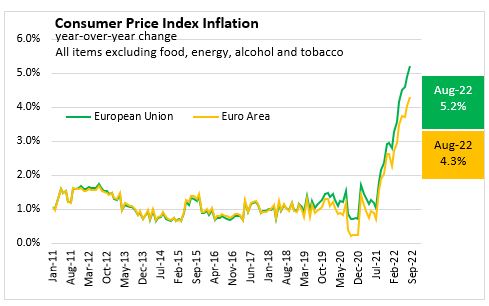
Source: Eurostat US CONSUMER PRICE INDEX, AUGUST 2022
The United States Consumer Price Index for All Urban Consumers increased 8.3% year-over-year in August. This was below the 8.5% increase reported in July 2022.
The seasonally adjusted index increased by 0.1% in August after no change in July. There were many contributors that contributed to the increase, among those were shelter, food and medical care. Energy index decreased with gasoline falling by 10.6% while the electricity and natural gas indexes increased. Index for all items less food and energy rose 0.6% in August.
The 12-month change in the CPI - all items less food and energy was 6.3% in August, an increase from 5.9% in July. Over the past 12 months, the energy index is up 23.8% with gasoline up 25.6%. The food index increased 11.4% compared to August 2021, the largest 12-month increase since May 1979.
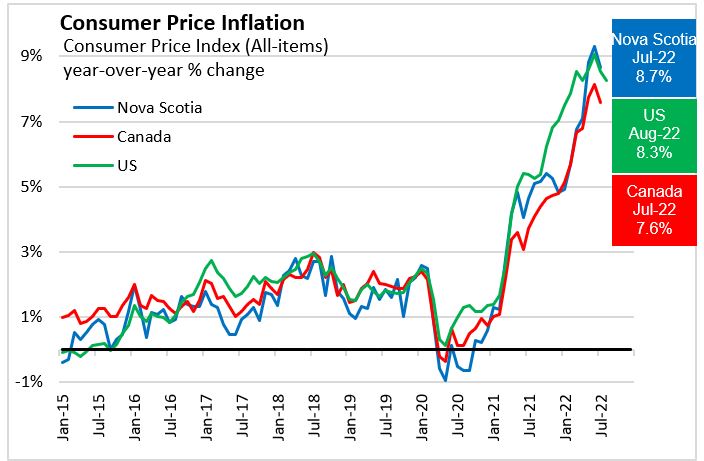
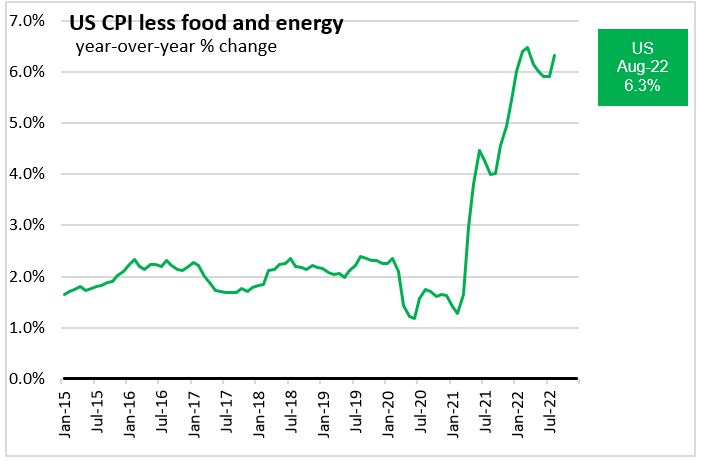
Note:
Canada and Nova Scotia August 2022 CPI figures will be released on September 20, 2022.
Sources:
Statistics Canada. Table 18-10-0004-01 Consumer Price Index, monthly, not seasonally adjusted
US Bureau of Labor Statistics, retrieved from FRED, Federal Reserve Bank of St. Louis
|